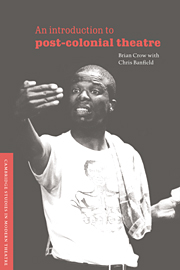Book contents
- Frontmatter
- Contents
- Preface
- Acknowledgements
- Introduction
- 1 Derek Walcott and a Caribbean theatre of revelation
- 2 August Wilson's theatre of the blues
- 3 Jack Davis and the drama of Aboriginal history
- 4 Wole Soyinka and the Nigerian theatre of ritual vision
- 5 Athol Fugard and the South African ‘workshop’ play
- 6 Badal Sircar's Third Theatre of Calcutta
- 7 Girish Karnad and an Indian theatre of roots
- Conclusion
- Further reading list
- Index
Preface
Published online by Cambridge University Press: 26 February 2010
- Frontmatter
- Contents
- Preface
- Acknowledgements
- Introduction
- 1 Derek Walcott and a Caribbean theatre of revelation
- 2 August Wilson's theatre of the blues
- 3 Jack Davis and the drama of Aboriginal history
- 4 Wole Soyinka and the Nigerian theatre of ritual vision
- 5 Athol Fugard and the South African ‘workshop’ play
- 6 Badal Sircar's Third Theatre of Calcutta
- 7 Girish Karnad and an Indian theatre of roots
- Conclusion
- Further reading list
- Index
Summary
A characteristic feature of the development of Western art forms during the twentieth century has been the frequent and highly fruitful exploitation by artistic practitioners of all kinds of materials drawn from non-Western cultures. This is as true of the theatre as it is of music, painting and sculpture. For example, a profound influence on Artaud's formulation of the Theatre of Cruelty was, famously, his discovery of Balinese dance-drama at the Paris Colonial Exhibition of 1931. Brecht seems to have discovered what epic acting could be only after he watched the Chinese actors of Mei Lan-fang's company in Moscow in 1935-More recently, two of the most influential figures in contemporary theatre, Jerzy Grotowski and Peter Brook, have drawn much of their inspiration from their encounters with the theatre of non-Western cultures – Grotowski mainly from Indian classical dance-drama, Brook from a variety of Oriental and African sources.
Creatively stimulating though these non-Western influences on European and American theatre have evidently been, one can ask legitimate questions about the extent to which Western practitioners have considered, understood or even much cared about the nature and significance of their borrowings in relation to their original cultural contexts. In this respect, as Rustom Bharucha and others have shown, the stylistic exploitation of, say, Indian forms of theatre has been largely opportunistic and culturally unequal, determined by the perceived needs of Western practitioners and audiences rather than by a genuine effort to confront Indian realities as they are refracted through its rich theatrical culture.
- Type
- Chapter
- Information
- An Introduction to Post-Colonial Theatre , pp. xi - xiiiPublisher: Cambridge University PressPrint publication year: 1996

